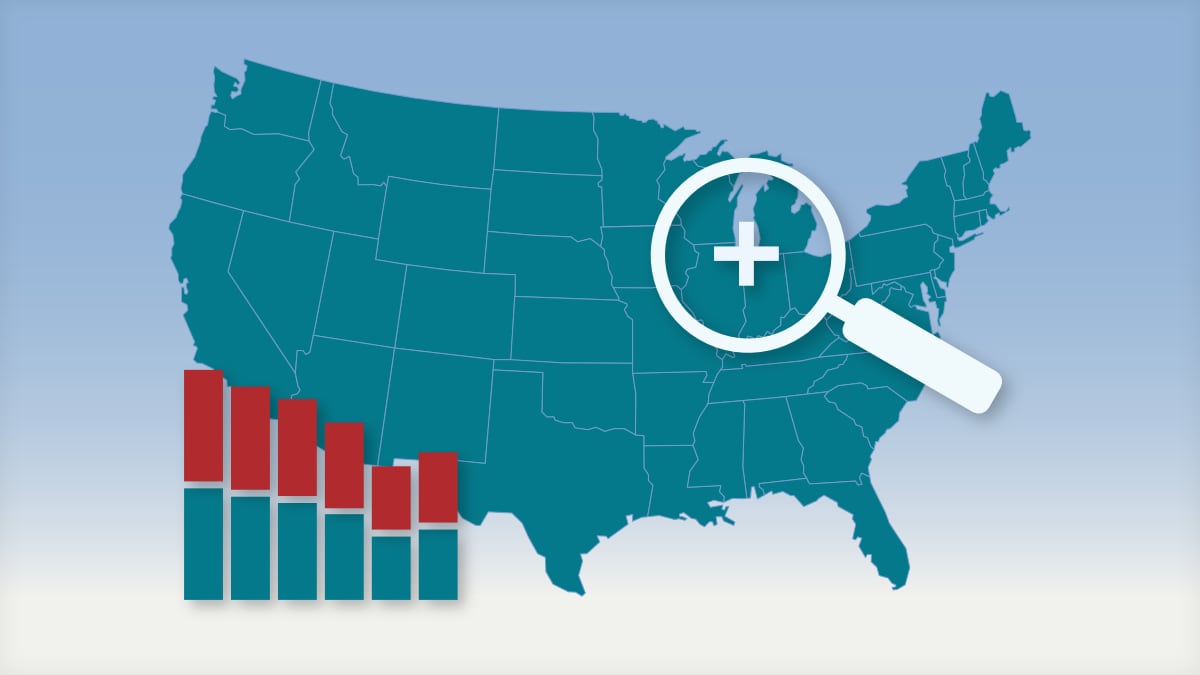At a glance
NCHHSTP AtlasPlus is an interactive tool that gives users the ability to create customized tables, maps, and charts using nearly 20 years of CDC's surveillance data on HIV, viral hepatitis, STD, and TB. AtlasPlus also provides access to indicators on social determinants of health (SDOH) allowing users to view social and economic data in conjunction with surveillance data for each disease.

AtlasPlus app
NCHHSTP AtlasPlus has Charts, Maps, and Tables functions. Using any of these functions, you can view diseases by year, geography, and demographics.
Charts
Using the Charts function, users can generate a series of charts that can be downloaded. In this section, users can interact with the available data on HIV, viral hepatitis, STD, tuberculosis (TB), and social determinate of health (SDOH) to:
- Create line graphs by year
- Generate pie charts for sex at birth
- Produce bar charts by age group, race/ethnicity, transmission category (HIV), country of birth (TB)
- Create bar charts by states or counties
- Make two side-by-side sets of charts; e.g., of two diseases or 1 disease and 1 SDOH
- Download the data into an Excel file
- Save the chart in a PowerPoint file.
Maps
The Map function in the NCHHSTP AtlasPlus enables users to:
- Create custom maps and examine patterns of HIV, viral hepatitis, STD, TB, or SDOH by geographic areas;
- Map data by a specific sex at birth, race/ethnicity, age group, transmission category (HIV cases), or country of birth (TB data);
- Create two side-by-side maps; e.g., of two diseases, two race/ethnicity groups, or two age groups;
- Create state-specific maps for indicators with county-level data
- Download the data into an Excel file; and,
- Save the map in a PowerPoint file.
Tables
The Tables function lets the user build tables based on the exact subset of the data the user wants to view. Using the Tables function, the user can create tables that:
- Compare two or more indicators to compare at the national, regional, state, or county level
- Examine multiple geographic areas (e.g., VA, MD, and DC);
- Display two or more years of data (e.g., 2010-2016);
- Examine subpopulations of interest (e.g., by race, age group, sex at birth); and,
- Can be downloaded into an Excel file.
What's new
CDC has paused PrEP coverage reporting to determine the best methodology for calculating PrEP coverage, and to update PrEP coverage estimates using updated methods and sources. Due to a formula error that affects a subset of race/ethnicity data, all race/ethnicity data will be removed from this site. CDC plans to resume PrEP coverage reporting in the next HIV Monitoring Report for all demographic groups, currently scheduled for publication in June 2025. Until updated PrEP coverage estimates are published, CDC advises against citing specific PrEP coverage data points, as historical estimates will be updated.
National HIV Prevention and Care Outcomes
New data
- Twelve National HIV Surveillance System (NHSS) indicators have been updated for data through 2022 at the national, state, regional, MSA, and county-levels and are based on HIV diagnoses reported to CDC through December 2023.
- Updated preliminary 2023 data on HIV diagnoses and linkage to HIV medical care at the national, state, and county level. Data for 2023 are considered preliminary (subject to 12-month reporting delay) and include HIV diagnoses reported to CDC through December 2023 and data for linkage to HIV medical care reported to CDC through September 2023.
- New data for persons aged 55-64 and aged ≥65 years for all NHSS indicators.
- New 2022 data on viral hepatitis diagnoses at the national and state levels.
- New 2022 data on STD diagnoses at the national, state, and county levels.
- New 2022 1-year estimates and 2018-2022 5-year estimates for the social determinant of health indicators.
- New 2022 data on tuberculosis diagnoses at the national, state, and county levels.
Diverse data characterization capabilities
- NEW: Region aggregation available for select indicators
- Line graphs by year.
- Pie or bar charts for sex.
- Bar charts for age group, race/ethnicity, transmission category (HIV), and country of birth (TB).
- Bar charts by states or by counties.
- Ability to create two side-by-side maps or charts, e.g., compare two diseases, or one disease and one social determinants of health indicator.
Enhanced data visualization
- Faster and cleaner data displays.
- Change from flash format to HTML5, which means faster and cleaner data displays, as well as mobile access.
Suggested citation
Centers for Disease Control and Prevention. NCHHSTP AtlasPlus. https://www.cdc.gov/nchhstp/about/atlasplus.html. Accessed [insert date].
Link to AtlasPlus with buttons
For convenience, we offer code snippets that render buttons that link to AtlasPlus.

